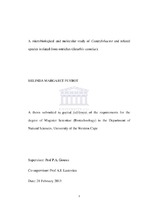| dc.description.abstract | Campylobacter and related Epsilonproteobacteria (Arcobacter and Helicobacter) are currently viewed as emerging pathogens and are able to cause gastroenteritis, bacteraemia, the Guillain-Barré syndrome, reactive arthritis and other diseases in humans. While poultry, cattle and sheep are known reservoirs for campylobacter, very little is known about ostriches as a vector for these organisms. What is known, however, is that these birds can and sometimes do get infected. Studies by various researchers have provided evidence that various species of animals shed Epsilonproteobacteria in their faeces. In this study, qualitative microbiological assays were performed on liver, caecum and colon samples predominantly from healthy ostriches presented for slaughter, to detect any Epsilonproteobacteria present. Samples were collected at an abattoir in the Western Cape between February and December 2010. Qualitative microbiological assays were also performed on 50 faecal samples collected on a farm. Epsilonproteobacteria were isolated from the tissue samples and characterized following the phenotypic and biochemical scheme presented in the Cape Town protocol. This protocol uses membrane filtration onto antibiotic-free Tryptose blood agar plates, and incubation at 37 ºC in a hydrogen-enhanced microaerobic atmosphere (Lastovica, 2006). The isolates were identified as C. jejuni subsp. jejuni. The multiplex PCR of Neubauer and Hess (2006) was applied to some of these isolates. A panel of isolates consisting of C. jejuni subsp. jejuni, C. fetus and E. coli was used to verify the DNA extraction procedure. The C. fetus and E. coli isolates were used as negative controls, and although DNA was successfully extracted from them, no bands were observed in the respective lanes of electrophoresed gels after application of the PCR. | en_US |

